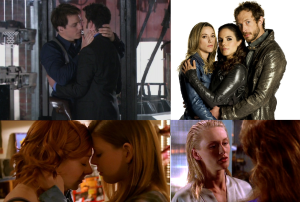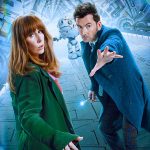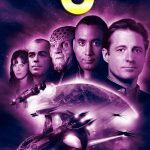Queer Heroes of Science Fiction and Fantasy
Queer characters on television, while becoming more prevalent, are very seldom the solo protagonists of their own show. If a queer character is featured, it’d typically part of an ensemble cast (Modern Family, Glee) or featured on a show where their sexual identity is the premise (Will and Grace, Queer as Folk). There are exceptions to the rule, of course, and as a self proclaimed geek I am proud that the vast majority of these exceptions are in the realms of science fiction and fantasy.
Captain Jack Harkness is the most obvious example of a modern day queer science fiction hero. He appeared in the first season (or season 27, if you’re a purist Whovian) of Doctor Who as a flirtatious time agent who becomes close with Rose and the Doctor during the London Blitz. Jack is omnisexual, being attracted to humanoids of all varieties, which appears to be a societal sexual norm in the 51st century. He flirts with both of them during his time on the show, causing fandom to write fanfiction shipping him with the Doctor (sometimes the Doctor and Rose at the same time) nearly from the beginning. He even kisses the Doctor at one point and, several seasons later, admits that he has feelings about the Time Lord to fellow companion, Martha Jones.
Then when he’s given his own spinoff show, Torchwood, his sexuality is more fully explored. He’s given a long term partner, Ianto Jones, and their relationship is written beautifully without overwhelming the science fiction plots of the show’s first three seasons. In fact, everyone on Torchwood seems a little bit bisexual to at least some degree. So not only is the primary protagonist omnisexual, but the universe he inhabits seems a lot more fluid in regards to sexuality than any show – drama or science fiction/fantasy – that I’ve ever seen. The topic of sexuality is only brought up briefly when Ianto informs his sister that he and Jack are in a relationship. Other than that, an open sexual preference appears to be readily accepted as the norm.
Though Captain Jack is the most prominent, he isn’t the only character who doesn’t fit the heterosexual norm, where a character is assumed straight until proven differently. Bo, a succubus from the Canadian produced show Lost Girl, has relationships with both men and women (faery and human alike) throughout the course of the show. Like Jack, she’s the protagonist of show, unlike the majority of queer characters. As a succubus, a large portion of her personality revolves around sexuality, but the story doesn’t focus only on that aspect of her. There’s an entire ongoing plot going on that has nothing to do with who Bo sleeps with or why. She’s simply bisexual and that’s just a part of who she is. It’s present and it’s a fact, but it’s not really an issue for anyone that she chooses to associate with.
Besides Bo and Jack, Willow Rosenberg (Buffy the Vampire Slayer) is the closest to a protagonist. She started off with an interest in men, but in season four she falls in love with Tara, a fellow student and witch. Her sexuality is discussed realistically, but after her initial coming out it becomes a non-issue.
Willow is responsible for opening the floodgate of explicitly queer secondary characters to grace our screens in the 2000s. We had Gaeta from Battlestar Galactica (shown in a relationship with Lt. Hoshi in the webisode The Face of the Enemy), Lafayette from True Blood, Sam Adama in Caprica, Edward Canton Delaware III from Doctor Who, Danny on Teen Wolf, and Renly Baratheon and Ser Loras from Game of Thrones (more on those two later). Queer characters have been around a lot longer than Willow, but they were a lot more subtle just a couple decades ago. In the early nineties we were graced with not one, but two lesbian relationships on screen though both are really only stated as such in one scene each and only hinted at for the rest of their perspective shows. These are, of course, Xena/Gabrielle and Susan Ivanova/Talia Winters (Babylon 5). In the 2000’s Willow and Tara were openly lesbians, kissing (something Joss fought the network very hard to include), cuddling, and lying in bed with one another, but the couples of the nineties barely touched on screen and anything more was only occasionally alluded to.
In the series finale of Xena, she and Gabrielle share a kiss on the lips, pushing the subtext of the show further than it had before. I was only a child at the time, but I remember how big of deal that kiss was to a lot of people. I remember my mom talking about it, but not wanting to talk about it because apparently it was so controversial and I was so young and she didn’t think it was really an appropriate topic for me (to be fair, she did discuss things like that when I grew older). But it stuck with me despite my distance from it and when Willow came out as a lesbian just a few years later I was finally old enough to start comprehending what queer representation on television meant. In 2003, Lucy Lawless essentially confirmed that all the subtext was accurate by describing them as “definitely gay,” though at that point I was very much focused on Willow as a lesbian icon since she came out as I was questioning my own sexuality.
Susan Ivanova and Talia Winters aren’t talked about as much as Gabrielle and Xena are, probably mostly due to the fandom being smaller (this should change, please drop what you are doing and go watch Babylon 5), but also due to its much more sublte nature. Ivanova and Talia have a complicated relationship. Ivanova starts off not being fond of Talia since she is a member of the Psi Corps, the organization responsible for taking her mother away when she was a child. But the two grow closer and by the end of season two Talia is spending the night at Ivanova’s apartment. In one particularly revealing scene Talia reaches out in bed in the middle of the night, apparently expecting to feel Ivanova next to her, but instead nothing is there and she gets up to investigate where she’s gone. The implications in that alone are massive, but several seasons later, after Talia’s departure, Susan states “I think I loved Talia,” lending even more legitimacy to their possible relationship. So no, nothing is ever shown – there are no kisses or cuddles – but even these subtle hints were more than most television in the nineties was willing to show.
Science fiction and fantasy novels were also exploring the topic at the time, though many (not all) were also very also subtle in their representation. In the HBO television adaptation of the popular fantasy series, Game of Thrones, Renly Baratheon and Ser Loras Tyrell are quite explicitly lovers, but in 1996 their relationship could have easily been overlooked in the thousands of pages of highly detailed story that spans across A Game of Thrones and A Clash of Kings. Part of this might have to do with the fact that HBO generally loves to push the envelope, even in it’s non-genre shows, but also due to the time period that the show has been made in versus when the book was written. There’s nearly a fifteen year gap between the two (though the show will start catching up to him soon since George RR Martin is legendarily slow at writing). We’re now in a post-Xena, post-Willow world. Jack Harkness and Bo are protagonists and heros. King Renly Baratheon and Ser Loras, Knight of the Flowers, can be lovers. Had this adaptation been done in the late nineties or early 2000’s, I’m not sure it would have been included so heavily in the adaptation.
Genre television is making huge progress as far as queer representation is concerned. Maybe we’ll have a queer lead on an American network show someday in a role that’s not entirely focused on their sexuality. Canada and the United Kingdom have them. And there are a ton of queer secondary characters already represented on networks and cable alike, but none of them are the protagonists. We’re almost there, but not quite.
Author: Angel Wilson
Angel is the admin of The Geekiary and a geek culture commentator. They earned a BA in Film & Digital Media from UC Santa Cruz. They have contributed to various podcasts and webcasts including An Englishman in San Diego, Free to Be Radio, and Genre TV for All. They identify as queer.
Help support independent journalism. Subscribe to our Patreon.
Copyright © The Geekiary
Do not copy our content in whole to other websites. If you are reading this anywhere besides TheGeekiary.com, it has been stolen.Read our









Check out Ethan of Athos by Lois McMaster Bujold if you get a chance.